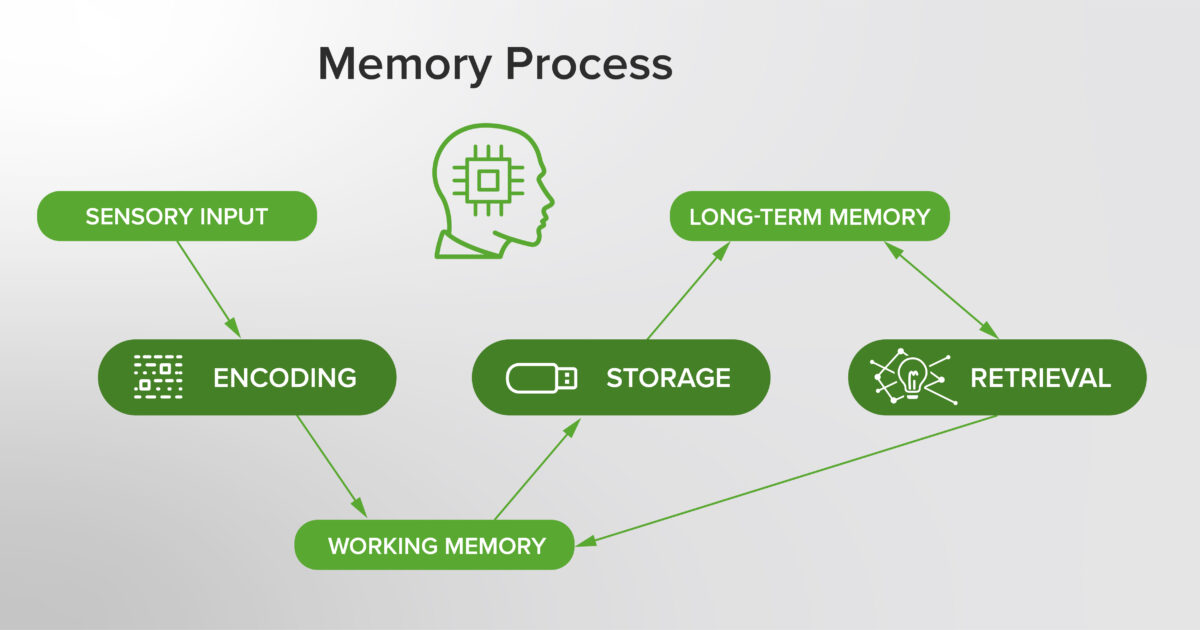Learning is defined as “the acquisition of knowledge or skills through study, experience, or being taught.”(1) There are a wide array of definitions of learning and various supporting theories, as well as multiple ways to look at learning as a concept. However, they share the underlying premise that the acquisition and retention of knowledge are foundational steps in the learning process, highlighting the importance of memory. Having a deeper understanding of memory can thus help educators enhance their students’ learning.
Memory Is Foundational to Learning in Medical Education
Bloom’s taxonomy is a tool of instructional design used for decades by teachers and learners alike.(2) It supports the process of learning by ordering the different cognitive skills students need to acquire into clear objectives and helping them to identify their level of mastery within the taxonomy.(3)
Bloom’s Taxonomy(2)

A key principle to note is that gaining, understanding and retaining information are foundational for the educational process (and in turn for medical practice). This is why learning strategies aim at ensuring long-term retention of knowledge. For these strategies to work, however, they must take into consideration the fundamental principles of how information retention works, that is, the processes of memory.
More details on the origins of Bloom’s taxonomy and its application in medical education can be found in our full-length academic article “Memory in Learning: Key Concepts and Principles to Enhance Medical Education.”
Different Types of Memory Can Be Exploited Using Different Strategies
Memory, the function of preserving information, involves the processes of encoding, storing and retrieving information. It can be broadly divided into two types: short-term and long-term memory.(4) Long-term memory can be further classified as declarative and nondeclarative memory.(5) The primary difference between the two types is that declarative memory is accessible to a person’s awareness, whereas nondeclarative memory is not.(6) The figure below illustrates these subtypes of long-term memory with some examples. The specific types are still a subject of debate among psychologists.(5)
Types and Subtypes of Memory(5)

Declarative versus nondeclarative memory
Both declarative and nondeclarative memory (specifically, procedural memory) are at play when people learn.(7,8) Information such as facts and events (declarative) is consciously processed through the neocortex,(9) whereas procedural memory is processed through the basal ganglia and happens unconsciously.(10) This difference in consciousness of processing means that explicit instruction can facilitate learning for declarative memory, but not for procedural memory.
Familiar examples from medical education:
- Declarative memory is involved in a student learning about the cranial nerves. The name, function, nucleus location, and other details of the cranial nerves are distinct pieces of information that can be explained and processed.
- Nondeclarative memory is involved in a student developing the skills and critical thinking to accurately diagnose and manage a cranial nerve lesion. These abilities develop more subtly over a longer period and entail a more complex learning process.
Given the difference in how these memory types work, they have different utility in teaching and learning. While declarative memory can be enhanced with memory strategies such as chunking and mnemonics (see below), nondeclarative memory is better enhanced with practice and experience through learning strategies such as spaced retrieval and interleaving.(11)
Strategies for Different Stages of the Memory Process
The memory process is classically described as consisting of three steps, namely encoding, storage, and retrieval.(12)
The Memory Process: From Sensory Input to Long-term Memory(12)

Encoding happens after the initial exposure to a stimulus (i.e., the material presented in some perceptual form), which is based on sensory input.(13) Encoding is a selective process: The brain is constantly being fed sensory information, but only a small portion is remembered due to the limited capacity of working memory. This limitation, however, acts independently on each of the channels through which information is processed. Thus, using more than one channel to transmit information, that is, dual coding, can enhance the encoding process.(14)
While working memory is limited, long-term memory is practically limitless in capacity.(15) The key to maximal retention, therefore, is to enhance the transfer of information from working memory to long-term memory and to enhance the ability of individuals to retrieve information from their long-term memory.
The second step in the memory process is storage. Memory consolidation, a process of structural and chemical changes on a neural level, is the hallmark of this stage.(16) Although depicted as a separate step in the process, the storage stage is not distinct from encoding. Storage can be improved by enhancing encoding, for example through:
- Elaborative encoding: building new information upon previously acquired information, requiring the learner to actively engage in cognitive processing.
- Semantic encoding: giving meaning to a piece of information using strategies such as chunking and mnemonics.(17)
Chunking is the process of trying to make sense of a string of information by forming it into meaningful chunks, as depicted in the figure below.(18)
An Example of Chunking(18)

The final step in the memory process is retrieval. This involves the access and utilization of information that has been encoded and stored,(19) and a failure in this step is the most common reason for forgetting.(20) The most recognizable application of retrieval in the context of education is assessment. Retrieving information from long-term memory can also be used to enhance memory consolidation and thus durable learning. For example, in the case of elaborative encoding, information from long-term memory is used as a scaffold on which to build new information. This dynamic interplay between long-term and working memory is the foundation of active learning.(21)
Students’ ability to retrieve information can be enhanced by retrieval practice, owing to what is referred to by psychologists as the testing effect. The testing effect has been studied for decades and has been demonstrated to be effective for durable learning in multiple educational settings.(17,22) Despite its importance, retrieval is underutilized as a study strategy by students(23) and as a teaching strategy by educators. The use of retrieval-based strategies in medical education will be discussed in depth in a future article.
Enhancing Memory Consolidation: Focused versus Diffuse Thinking
The hippocampus plays a major role in the processing of information during learning. This act of processing forms memories that are temporary and prone to loss, and the use of this information is dependent upon the work of the hippocampus. Memory consolidation is the process by which this dependency on the hippocampus is eliminated through establishing neural circuits in the brain.(9) Research shows that consolidation happens best when the hippocampus is not engaged in encoding new information, essentially being free for consolidation.(24)
This freedom for consolidation is a hallmark of what Barbara Oakley calls diffuse thinking mode, which she contrasts with focused thinking mode:(25)
- Diffuse thinking refers to a passive internal process of thinking in which the brain is not actively engaged in a specific task. It allows for broader conceptual understanding and linking new information with previous information.
- Focused thinking is utilized when thinking of a solution to a problem or when consciously thinking about new information being acquired.
Oakley argues that learning requires both modes of thinking.(25) Intervals of diffuse thinking are paramount for the retention of learned information and this provides a strong argument for the importance of regular breaks and resting in between study sessions. There is also robust evidence to support the important role of sleep in consolidation, based on years of molecular and phenomenological research.(26) This is also one of the foundational principles of spacing as a learning strategy, which will be discussed in future articles.(27)
Focused vs. Diffuse Modes of Thinking(25)

Practical Recommendations for Medical Educators
- Consider whether the material falls under declarative or nondeclarative knowledge when teaching your students. Declarative information can be enhanced by direct instruction, whereas procedural knowledge is best enhanced by retrieval and practice.
- Encourage students to elaborate on topics they are learning about in order to promote elaborative encoding. This can be done by asking students to summarize new information that they have learned and to put this newly learned information into the context of previous knowledge.
- Exploit multiple encoding channels by dual coding when developing or delivering content.
- Encourage use of memory-enhancing strategies such as chunking and mnemonics.
- Remind students that practice makes perfect and emphasize the practice of retrieval, a type of practice that is needed and often not given much importance. Rereading or simply reviewing is not sufficient.
- Consider the need to allow students to have a sufficient interval for entering into diffuse thinking mode. This can be achieved by spacing lessons, incorporating breaks within lessons, and encouraging students to take breaks while studying.
- Remind your students that memory consolidation can be improved by sufficient rest and healthy sleep patterns.
- Consider institution-wide changes that will enable the implementation of these evidence-based strategies.
To optimize learning, educators need to ensure that the strategies utilized in delivering and reinforcing content are consistent with how the human brain processes, stores, and retrieves information. The use of mnemonics, retrieval-based strategies, and strategies that assist with encoding facilitates memory processing and retention and should be employed to maximal effect.
Would you like to learn more about this topic? Read the in-depth article, “Memory in Learning: Key Concepts and Principles to Enhance Medical Education,” in which Bloom’s taxonomy and its relevance to medical education, as well as memory principles and processes, are explored in greater detail.
Self-Quiz
(Please select all that apply)
1. Which statements about Bloom’s taxonomy are correct?
a. Remembering is foundational for the educational process.
b. Bloom’s taxonomy can be used for instructional design and assessment.
c. Evaluation is on the top of the pyramid.
d. Synthesizing new ideas is foundational for the educational process.
2. Which of the following statements are true?
a. Students can be easily taught procedural knowledge in a classroom setting.
b. Declarative information can be enhanced by direct instruction, whereas procedural knowledge is best enhanced by retrieval and practice.
c. Some students rely on declarative memory, while others rely predominantly on procedural memory.
3. Which of the following statements are true?
a. Long-term memory has a capacity limit that varies from one learner to another.
b. Diffuse thinking allows for broader conceptual understanding and linking of new information with previous knowledge.
c. The most common reason for forgetting is a failure in retrieval.
d. In the context of medical education, educators need to consider different memory types and tailor their instruction accordingly.
Correct answers: (1) a, b. (2) b. (3) b, c, d.
Online Seminar
This online seminar from Lecturio’s Durable Learning series explores how an understanding of memory and its different types can be employed within the context of medical education. We also provide hands-on recommendations for educators to make learning more effective.
Watch the seminar recording:
Would you like to learn more? Explore the Pulse Seminar Library.



